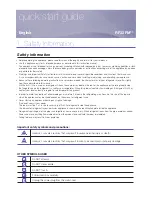
• In the event of a power failure, call the local offi ce of your Electricity Company and ask how long it is going to last.
- Most power failures that are corrected within an hour or two will not affect your refrigerator temperatures.
However, you should minimize the number of door openings while the power is off.
- But should the power failure last more than 24 hours, remove all frozen food.
• If keys are provided with the refrigerator, the keys should be kept out of the reach of children and not be in the
vicinity of the appliance.
• The appliance might not operate consistently (possibility of defrosting of contents or temperature becoming too
warm in the frozen food compartment) when sited for an extended period of time below the cold end of the range of
temperature for which the refrigerating appliance is designed.
• Do not store food which goes bad easily at low temperature, such as bananas, melons.
• Your appliance is frost free, which means there is no need to manually defrost your appliance, as this will be carried
out automatically.
• Temperature rise during defrosting can comply with ISO requirements.
But if you want to prevent an undue rise in the temperature of the frozen food while defrosting the appliance, please
wrap the frozen food up in several layers of newspaper.
• Any increase in temperature of frozen food during defrosting can shorten its storage life.
• Do not re-freeze frozen foods that have thawed completely.
- The California Safe Drinking Water and Toxic Enforcement Act requires the Governor of California to publish a list of
substances known to the State of California to cause cancer, birth defects, or other reproductive harm, and requires
businesses to warn of potential exposure to such substances.
This product contains a chemical known to the State of California to cause cancer, birth defects, or other
reproductive harm. This appliance can cause low-level exposure to some of the substances listed, including benzene,
formaldehyde, and carbon monoxide.
ADDITIONAL TIPS FOR PROPER USAGE
• DANGER : Risk of child entrapment. Before you throw away your old refrigerator or freezer:
- Take off the doors and door latch.
- Leave the shelves in place so that children cannot easily climb inside.
• Leave the shelves in place so that children may not easily climb inside.
• Ensure that none of the pipes on the back of the appliance are damaged prior to disposal.
• R-600a or R-134a is used as a refrigerant. Check the compressor label on the rear of the appliance or the rating
label inside the refrigerator to see which refrigerant is used for your refrigerator.
When this product contains fl ammable gas (Refrigerant R-600a), contact your local authority in regard to safe
disposal of this product. Cyclopentane is used as an insulation blowing gas.
The gases in insulation material require special disposal procedure.
Please contact your local authorities in regard to the environmentally safe disposal of this product. Ensure that none
of the pipes on the back of the appliances are damaged prior to disposal. The pipes shall be broken in the open
space.
• When disposing of this or other refrigerator/s, remove the door/door seals, door latch so that children or animals
cannot become trapped inside. Children should be supervised to ensure that they do not enter and play with the
appliance.
- If trapped inside, the child may become injury and suffocate to death.
• Please dispose of the packaging material for this product in an environmentally friendly manner.
• Keep all packaging materials well out of the reach of children, as packaging materials can be dangerous to children.
- If a child places a bag over its head, it may result in suffocation.
SEVERE WARNING SIGNS FOR DISPOSAL
STATE OF CALIFORNIA PROPOSITION 65 WARNINGS:
































